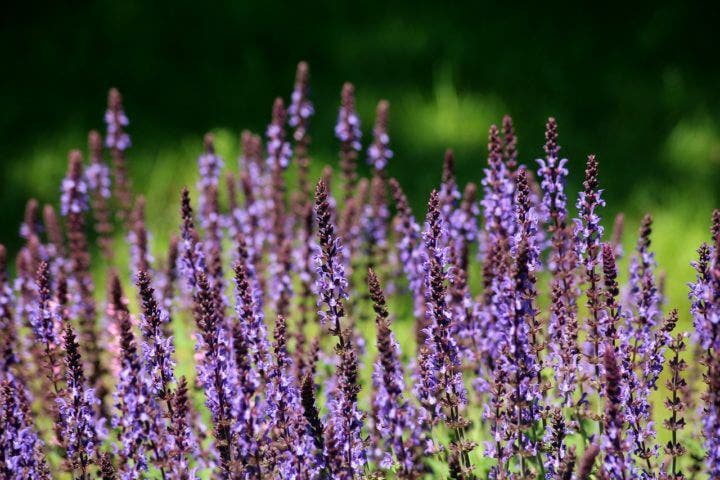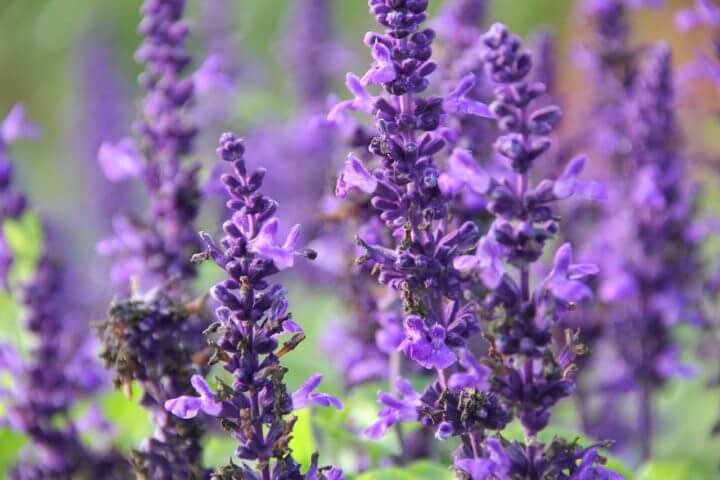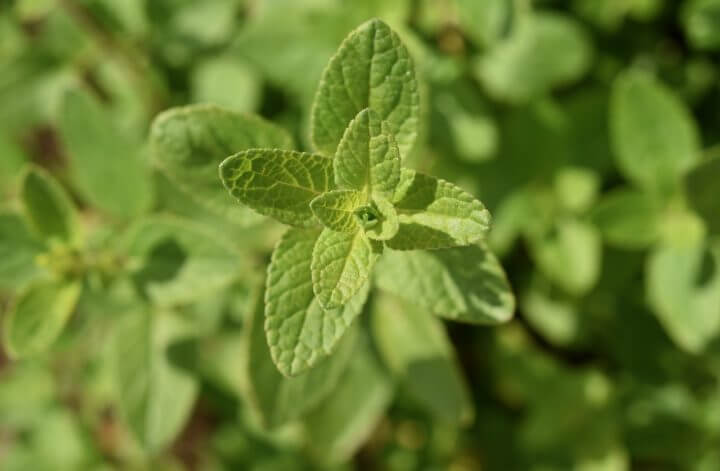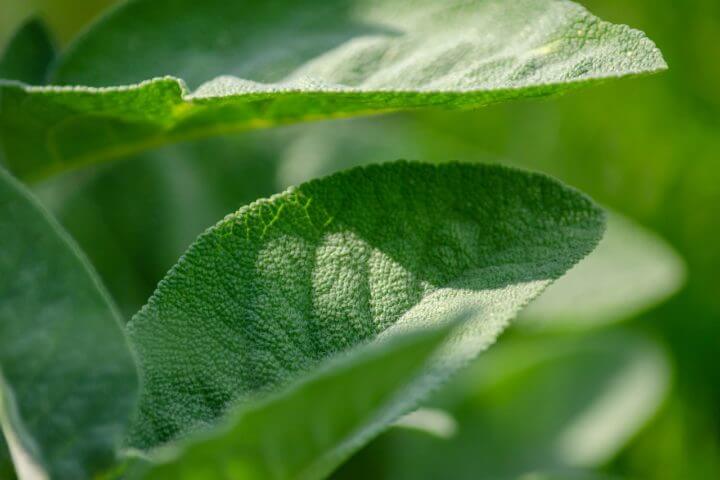Common sage, also known as salvia officinalis , is a rustic-looking plant that has its origins in the Mediterranean. It belongs to the same family as mint and grows in the form of a bush.
In general, it has a wide range of uses. It is used for beauty treatments, so it is common to find its aroma in creams and lotions for skin or hair care. Also, it is used for gastronomic purposes, either as a spice or in the preparation of sage tea.
Discover 7 potential benefits of sage tea .

7 benefits of sage tea
1. It is rich in anti-inflammatory and antioxidant compounds
The antioxidants in sage tea are known to neutralize free radicals. The accumulation of these types of harmful compounds is associated with chronic diseases such as type 2 diabetes and some types of cancer (Hamidpour, Hamidpour, Hamidpour & Shahlari, 2014).
In addition, sage tea is rich in rosmarinic acid , an antioxidant, which according to a study in animals and test tubes, is effective in reducing inflammation and blood sugar levels (Azevedo et al., 2011).
Another study carried out in animals, showed that sage extract considerably increases the levels of anti-inflammatory compounds that circulate in the blood, while decreasing those that promote inflammation (Ben Khedher et al., 2018). However, more human research is needed to certify the anti-inflammatory and antioxidant effects of sage tea .

2. Promotes healthy skin and better wound healing
Sage is used in topical skin care cosmetics, so drinking its tea is believed to have the same benefits.
A test-tube study of mouse skin cells found that camphor, an important compound in sage, promotes healthy skin cell growth , delays signs of aging, and reduces wrinkle formation (Tran, Ho , Song, Cho and Cho, 2015).
Other animal studies claim that sage extract helps treat cold sores and accelerates wound healing (Reuter, Wölfle, Weckesser & Schempp, 2010).

3. Improves oral health
Sage is highly recommended in dentistry . This plant not only attacks pain, inflammation and bad breath, but also provides antibacterial and healing properties (Taheri, Azimi, Rafieian and Zanjani, 2011). Gargling with sage tea is even recommended for mouth wounds and sore throats (Walch, Tinzoh, Zimmermann, Stühlinge & Lachenmeier, 2011).

4. Has anti-cancer properties
Sage tea is believed to be able to fight cancer cells because it contains compounds such as carnosol, camphor, and rosmarinic acid.
Studies in animals and test tubes have shown that carnosol can destroy various types of cancer cells without affecting healthy cells (Johnson, 2011). Likewise, an investigation in more than 500 people showed that both sage tea and chamomile tea are associated with a decrease in the risk of developing thyroid cancer (Riza et al., 2015).

5. Helps control blood sugar
Sage is a popular ingredient in alternative medications to improve blood sugar levels and treat type 2 diabetes.
A 2-month study in 105 adult type 2 diabetes patients found that a supplement of 500 mg of sage extract 3 times a day can improve fasting glucose, after meals and hemoglobin A1c (Kianbakht, Nabati and Abasi, 2016).

6. Improves female health
Sage provides unique health benefits for women . In the Middle East, pregnant women use this plant to avoid nausea. Similarly, it is used to reduce the production of breast milk during weaning or when it is excessive. However, more research is still needed to support these traditional uses.
On the other hand, an 8-week study in 71 menopausal women found that taking a daily tablet containing fresh sage reduces the strength and frequency of hot flashes by 64% (Kargozar, Azizi and Salari, 2017).

7. Promotes heart health
A 4-week study of 6 women showed that drinking 10 ounces (300 ml) of sage tea twice a day can reduce total cholesterol by 16% and bad cholesterol (LDL) by 20%. In turn, it can increase good cholesterol (HDL) by 36% (Sá et al., 2009).
Similarly, a 2-month investigation of 105 type 2 diabetes patients found that those who took 500 mg of sage extract 3 times a day had healthier levels of triglycerides and cholesterol (Kianbakht, Nabati and Abasi, 2016). However, more research is still needed.

Sage tea side effects
Drinking sage tea can also have drawbacks . This plant has a compound called thujone that is toxic in high doses. If you take 3-7 g of thujone a day, you can experience heart problems, seizures, vomiting, and kidney damage.
Fortunately, sage tea only contains 4 to 11 mg of thujone per 4 cups (1 L), so you can drink several cups a day without risking toxicity from this compound. On the other hand, it is necessary to avoid sage essential oil , since only 12 drops can be toxic.
In general, sage tea or infusion is safe in normal amounts, but if you have any questions, it is best to ask your doctor.

Conclution
Sage tea has many emerging benefits , but you should keep in mind that most of the studies related to this plant have been done on animals and test tubes, so the effects can be much less. Also, be sure to ingest normal amounts of this tea, as excessive consumption can be toxic.
References
- Azevedo, MF, Lima, CF, Fernandes-Ferreira, M., Almeida, MJ, Wilson, JM and Pereira-Wilson, C. (2011). Rosmarinic acid, major phenolic constituent of Greek sage herbal tea, modulates rat intestinal SGLT1 levels with effects on blood glucose. Molecular Nutrition & Food Research. doi: 10.1002 / mnfr.201000472
- Ben Khedher, MR, Hammami, M., Arch, J., Hislop, DC, Eze, D., Wargent, ET,… Zaibi, MS (2018). Preventive effects of Salvia officinalis leaf extract on insulin resistance and inflammation in a model of high fat diet-induced obesity in mice that responds to rosiglitazone. PeerJ. doi: 10.7717 / peerj.4166
- Hamidpour, M., Hamidpour, R., Hamidpour, S. and Shahlari, M. (2014). Chemistry, Pharmacology, and Medicinal Property of Sage (Salvia) to Prevent and Cure Illnesses such as Obesity, Diabetes, Depression, Dementia, Lupus, Autism, Heart Disease, and Cancer. Journal of Traditional and Complementary Medicine. doi: 10.4103 / 2225-4110.130373
- Johnson JJ (2011). Carnosol: a promising anti-cancer and anti-inflammatory agent. Cancer letters. doi: 10.1016 / j.canlet.2011.02.005
- Kargozar, R., Azizi, H., & Salari, R. (2017). A review of effective herbal medicines in controlling menopausal symptoms. Electronic physician. doi: 10.19082 / 5826
- Kianbakht, S., Nabati, F., & Abasi, B. (2016). Salvia officinalis (Sage) Leaf Extract as Add-on to Statin Therapy in Hypercholesterolemic Type 2 Diabetic Patients: a Randomized Clinical Trial. International Journal of Molecular and Cellular Medicine, 5 (3), 141–148
- Riza, E., Linos, A., Petralias, A., de Martinis, L., Duntas, L. and Linos, D. (2015). The effect of Greek herbal tea consumption on thyroid cancer: a case-control study. European Journal of Public Health. doi: 10.1093 / eurpub / ckv063
- Reuter, J., Jocher, A., Hornstein, S., Mönting, JS and Schempp, CM (2007). Sage extract rich in phenolic diterpenes inhibits ultraviolet-induced erythema in vivo. Medical Plant, 73 (11): 1190-1
- Reuter, J., Wölfle, U., Weckesser, S. and Schempp, C. (2010), Which plant for which skin disease? Part 1: Atopic dermatitis, psoriasis, acne, condyloma and herpes simplex. JDDG: Journal der Deutschen Dermatologischen Gesellschaft. doi: 10.1111 / j.1610-0387.2010.07496.x
- Sá, CM, Ramos, AA, Azevedo, MF, Lima, CF, Fernandes-Ferreira, M., & Pereira-Wilson, C. (2009). Sage tea drinking improves lipid profile and antioxidant defenses in humans. International Journal of Molecular Sciences. doi: 10.3390 / ijms10093937
- Taheri, JB, Azimi, S., Rafieian, N. and Akhavan Zanjani, H. (2011), Herbs in dentistry. International Dental Journal. doi: 10.1111 / j.1875-595X.2011.00064.x
- Tran, TA, Ho, MT, Song, YW, Cho, M. and Cho, SK (2015). Camphor Induces Proliferative and Anti-senescence Activities in Human Primary Dermal Fibroblasts and Inhibits UV-Induced Wrinkle Formation in Mouse Skin. Phytotherapy Research: PTR. doi: 10.1002 / ptr.5484
- Walch, SG, Tinzoh, LN, Zimmermann, BF, Stühlinger, W., and Lachenmeier, DW (2011). Antioxidant Capacity and Polyphenolic Composition as Quality Indicators for Aqueous Infusions of Salvia officinalis L. (sage tea). Frontiers in pharmacology. doi: 10.3389 / fphar.2011.00079
